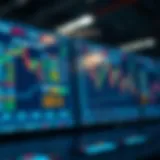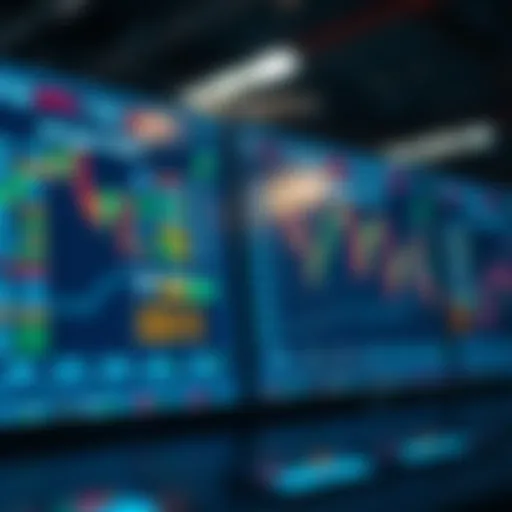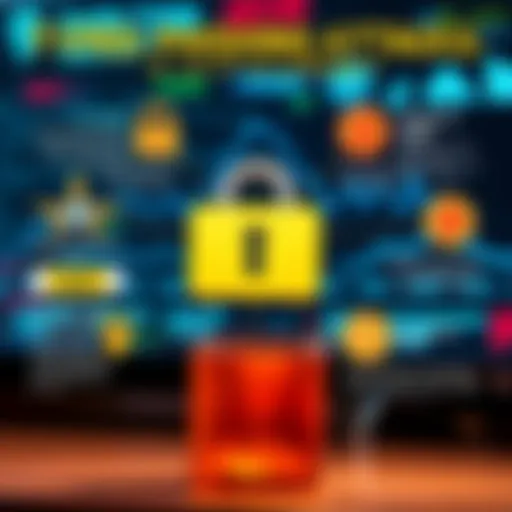Exploring NFTs and Their Impact on the Literary World


Intro
The buzz surrounding non-fungible tokens (NFTs) has swelled immensely over the past few years, driving conversations across multiple sectors. At the intersection of this innovative digital asset class and the literary world, a transformative narrative emerges. This exploration isn't just about flashy digital artworks or meme-fueled collectibles; it digs into the serious implications for authors, publishers, and readers alike. By intertwining the world of literature with the dynamic universe of tokenization, NFTs provide a myriad of opportunities and challenges.
Moreover, tokenization redefines ownership in ways that extend beyond mere possession. For readers, it opens avenues for engaging with their favorite stories and authors on unprecedented levels, fostering a unique bond through digital assets that feel personal. For authors, NFTs can be game-changing, particularly in how they control their work and reap financial rewards.
In this article, we'll dissect the relevant trends, market dynamics, and future potential of NFTs in literature. By tackling each theme organically, we’ll highlight the profound changes stirring beneath the surface, emphasizing a bright path ahead for both creators and consumers.
Market Analysis
Current Trends in Cryptocurrency
The cryptocurrency market, although often volatile, continues to attract attention. With Bitcoin and Ethereum frequently leading the pack, the introduction of NFTs has carved out a niche worth exploring. Investors are increasingly considering NFTs as a viable asset class, especially given the growing intersection with various forms of digital content, including literature.
Key aspects of the current trends include:
- A surge in platforms where authors can mint their own NFTs, like OpenSea and Rarible.
- Increased interest from traditional publishing houses experimenting with NFT projects.
- Readers becoming collectors, not just consumers, adding another layer to the book experience.
Price Prediction Techniques
Predicting the price of NFTs involves several strategies, akin to forecasting stocks but with distinct nuances. The uniqueness of each digital asset brings a challenging aspect to price prediction.
Common methods include:
- Market Comparables: Analyzing the price of similar NFTs to gauge market value.
- Sales History: Reviewing previous sales data to identify trends.
- Community Engagement: Assessing the popularity of the associated content, which can impact the NFT's desirability.
As the digital landscape evolves, recognizing correlation patterns between the NFT market and overall cryptocurrency movements can provide critical insights.
By understanding these current trends and prediction techniques, stakeholders can better navigate the complexities present within this unfolding digital narrative. This understanding serves as a foundation for exploring investment strategies and dissecting the broader implications of tokenization on literature.
Investment Strategies
Long-Term vs Short-Term Investing
Investing in NFTs resembles a game of chess, where foresight proves invaluable. Long-term investors tend to view NFTs as potential heirlooms, appreciating their value over time, while short-term traders often chase quick gains linked to hype.
For instance, an investor might purchase a lesser-known author’s NFT with the hope that they grow in popularity, while another could buy into a hot new release, aiming to flip it for profit shortly after launch.
Risk Management in Crypto Trading
No investment is without risk, and navigating the NFT space demands a robust risk management strategy. Key practices include:
- Diversification: Don’t put all your eggs in one basket. Owning a variety of NFTs across genres and genres helps mitigate risks.
- Research: Stay informed about trends, market conditions, and artist reputations.
- Setting Budgets: Establish clear budgets for investment, helping to curb emotional decision-making.
In summary, the juxtaposition of the literary landscape and NFTs holds potential that is just beginning to be unlocked. From market analysis to investment strategies, understanding these interconnected elements can enhance one’s navigation through this digital renaissance in literature.
Prelude to NFTs
The rise of non-fungible tokens (NFTs) has stirred conversation and curiosity across various sectors, including art, music, and most notably, literature. Understanding NFTs is paramount for anyone trying to grasp how they can reshape not just individual ownership but also the entire publishing ecosystem. This section saddles up to explore the essence of NFTs, laying the groundwork for their intricate relationship with books and tokenization.
NFTs stand as a testament to the shift towards digital ownership. Unlike cryptocurrencies that can be exchanged for one another, non-fungible tokens signify unique assets. Each NFT possesses distinct characteristics that set it apart from others. This quality has sparked an evolving dialogue about digital ownership and provenance, especially in contexts where authenticity matters, such as art and literature.
In literature, the introduction of NFTs opens a new frontier for authors and readers alike. For writers, NFTs provide a mechanism to tokenize their work, enabling them to sell directly to audiences without the need for traditional intermediaries like publishers. This transformation not only enhances revenue potential but also dissolves the barriers that have historically limited authors in expressing and monetizing their creativity.
Readers might benefit from this ecosystem through increased access to original works and the opportunity to engage with authors in novel ways. However, it is essential to recognize the considerations that come with this change, particularly concerning copyright and moral rights.
"NFTs extend beyond mere currencies; they represent a shift in how we perceive ownership and value in the digital age."
To better understand this new landscape, one must first dive deeper into what NFTs truly are and the technology that underpins them.


Understanding Non-Fungible Tokens
Non-fungible tokens are digital certificates of ownership stored on a blockchain, a technology that ensures their authenticity and traceability. Unlike Bitcoin or Ethereum—the interchangeable digital coins—NFTs are unique digital assets that may represent various forms of media, from visuals to text. What makes them non-fungible is that each token has distinct information or attributes that differentiate it from others.
NFTs can embody anything from a song to a piece of digital art, and in our scope, they can represent the ownership of an eBook or a unique written work. This creates opportunities for innovative business models and monetization strategies, including royalties for authors with every resale of their work.
Many are wonderstruck by the barriers NFTs can break down, potentially allowing for fractional ownership, where multiple people can own a share of a single piece of content, thus democratizing access to literary works.
The Technology Behind NFTs
At the heart of NFTs lies blockchain technology. This decentralized ledger not only records transactions but also ensures that ownership details remain immutable and transparent. Ethereum has emerged as the most popular platform for creating NFTs, employing smart contracts—automated protocols that facilitate, verify, or enforce contracts on the blockchain.
The process typically unfolds as follows:
- A creator mints an NFT by uploading their work onto a blockchain platform, embedding it with metadata that may include the title, author, and even digital signatures.
- The NFT becomes tradable on various marketplaces, where collectors can purchase, sell, or trade these tokens.
- Smart contracts stipulate the terms of ownership, resale rights, and commission for the original creator on secondary sales, ensuring continuous revenue.
This range of functionalities not only benefits creators but also provides a sense of security for collectors, knowing they possess a verifiable piece of digital property. However, as with any technology, challenges with scalability, energy consumption, and legal aspects surrounding NFT ownership remain as discussions unfold.
The Literary Landscape
The literary landscape is undergoing a seismic shift, with non-fungible tokens (NFTs) and tokenization at the forefront. At its core, this landscape represents the intricate relationship between authors, publishers, and readers, all of whom are now navigating a digital terrain infused with new technologies. This section highlights the importance of understanding these dynamics, as they not only redefine how literature is created and consumed but also pose critical benefits and considerations that cannot be overlooked.
In examining the literary landscape, several pivotal elements emerge:
- New Distribution Channels: With the rise of digital formats and NFTs, authors are given pathways to bypass traditional publishing houses, enabling direct sales to consumers.
- Enhanced Ownership: The concept of tokenization allows for unique ownership experiences. Readers can purchase authenticated versions of works, giving them a sense of pride and individuality.
- Better Revenue Models: Authors can leverage blockchain technology to receive payments directly, ensuring they earn a fair share without intermediaries skimming profits.
Traditional Publishing Challenges
The routes to publication have long been fraught with challenges. Traditional publishing methods involve numerous gatekeepers—the literary agents, editors, and publishers—all wielding considerable power over what reaches the audience. The result? Many talented authors find themselves lost in the shuffle, struggling to gain visibility. Moreover, the rigid structures of traditional publishing can be stifling, often prioritizing profit margins over creative expression.
- Gatekeeping: Only a fraction of submissions make it to publication, leaving countless voices unheard.
- Profit Distribution: Authors often see minimal royalties while publishers take hefty cuts. The traditional model appears unfair, particularly to emerging writers.
- Market Constraints: Publishers frequently depend on what has historically sold well, stifling innovative ideas that may not conform to existing trends.
All of these factors create a landscape that can be disheartening for authors and readers alike, contributing to a cycle that favors commercial success over artistic integrity.
Digital Transformation in Literature
Digital transformation serves as a harbinger of change in literature. The infusion of technology shifts the production, distribution, and consumption of written works. For instance, e-books have rescinded physical constraints, enabling more accessibility to literature. But this is just scratching the surface.
- Interactive Storytelling: Digital media has birthed new forms of storytelling, such as interactive novels and immersive narratives, putting the reader right in the action.
- Community Engagement: Platforms for self-publishing and social media create a two-way dialogue between authors and readers. Feedback mechanisms allow writers to hone their craft in real-time based on reader responses.
- Cross-Genre Expansion: Digital formats encourage experimentation across genres, leading to innovative storytelling that merges fiction, poetry, and even gaming.
As the literary landscape continues to evolve, embracing the possibilities offered by NFTs and digital solutions is paramount. By understanding these dynamics, stakeholders can better navigate the complexities of this burgeoning market, leading to a future where literature is more inclusive and creatively vibrant.
"As technology reshapes how stories are told, every reader has the potential to become a part of the narrative."
For a deeper understanding of transitioning from traditional to digital, check out Wikipedia's comprehensive overview on the digital publishing environment .
This new era transcends mere book sales; it reimagines the paradigms of ownership, creativity, and community within the literary field.
NFTs in the Publishing Sector
The role of NFTs (Non-Fungible Tokens) in the publishing sector cannot be overstated. As the literary world grapples with rapid digital transformation and evolving consumer preferences, NFTs emerge as a beacon of innovation that holds the potential to reshape traditional book ownership and distribution. This section explores the unique elements that make NFTs a game changer for authors, publishers, and readers.
One significant aspect of NFTs is their ability to provide traceable ownership of a digital asset. Unlike standard digital books, which can be duplicated endlessly, an NFT can represent a unique digital item, ensuring that the buyer owns an original copy. This characteristic addresses a common complaint among authors regarding their lack of control over the distribution and profitability of their work. Imagine a scenario where authors can sell their work directly to readers, maintaining a larger share of the profits and receiving royalties with every resell through smart contracts embedded in the NFT.
Furthermore, NFTs can introduce a myriad of new revenue streams through exclusive content. Authors can attach not only the digital copy of their book but also bonus materials such as behind-the-scenes content, audiobooks, or even private online readings. This model of fractional ownership enables fans to own parts of literary works in a way that makes being a part of the author’s journey more engaging.
However, integrating NFTs into the publishing realm necessitates careful consideration of the prevailing intellectual property rights. There’s a delicate balance to be reached, ensuring authors can capitalize on their creations without stepping on the toes of existing copyright frameworks. In a world where technology sometimes races ahead of legislation, this poses its unique set of challenges.
To illustrate the transformative impact of NFTs further, we delve into specific changes in book ownership and notable case studies of NFT books.
How NFTs are Changing Book Ownership


NFTs are fundamentally shifting the paradigm of book ownership. Traditionally, purchasing a book meant obtaining permission to read it, but not to own it in the full sense. With an NFT, collectors possess a unique, verifiable token that indicates true ownership of a specific edition of a book. This is an evolution in how we perceive value in literature.
When we think of a signed physical book, we often associate it with personal value or rarity. NFTs replicate this experience in the digital space. By enabling authors to create signed editions as NFTs, they can offer limited releases that tantalize collectors in new and profound ways. As a result, readers and collectors are finding more value in owning rare editions of digital works.
Moreover, the resale market for NFT books is opening avenues for financial returns. Authors could gain residual income through royalty structures established in the blockchain, generating a continuous stream of income with every sale. This system enhances the economic viability of self-publishing and empowers authors to establish a direct connection with their audience.
Case Studies of NFT Books
The Rise of NFT Novels
The concept of NFT novels signifies an evolving landscape in literary publishing. Forward-thinking authors are leveraging blockchain technology to release their works as NFTs, allowing readers to purchase, trade, and sell their novels in novel ways. One striking example is the debut of "World of Women" by Yam Karkai, which demonstrates how storytelling can collaborate with digital art to create an immersive experience.
The rise of these NFT novels contributes to a more dynamic interaction between readers and authors. The inclusion of interactive elements, like reader feedback shaping future editions, gives both groups a stake in the literary journey. This trait of reciprocity fosters a sense of partnership rarely seen in the traditional publishing arena.
From the perspective of collectors, the unique aspects of NFT novels, such as exclusive content and the option for personalized author interactions, make them an appealing investment and highly popular choice among tech-savvy readers. However, some challenges, such as the environmental impact of blockchain technology, raise concerns worth discussing.
Artistic Collaborations with Authors
Artistic collaborations between authors and visual artists are emerging as a noteworthy feature of the NFT landscape. By joining forces, creators are blending narrative and visual art in innovative ways, with memorable results. One prominent case is "CryptoPunks" where pixel art and literary excerpts marry, inviting collectors to experience art and story in unison.
This collaboration often results in unique NFTs that appeal not only to literature enthusiasts but also to art collectors. The key blend of media allows authors to reach broader audiences, while visual artists can find a new outlet for their work. Unique features of these collaborations often include limited runs of collectibles alongside the literary texts that they accompany, enhancing scarcity and driving demand.
Though such collaborations present exciting opportunities, they also introduce complexities regarding rights management, particularly when multiple artists are involved. Proper agreements must be established to navigate the intellectual property landscape, ensuring equitable treatment for all involved.
In summary, NFTs are planting the seeds of change in the publishing sector. They revolutionize book ownership and create myriad possibilities for collaborations, benefitting not only authors but also artists and readers alike. The implications of this transition touch various aspects of publishing, outlining a future that holds great potential and challenges for stakeholders in this evolving literary landscape.
"As the publishing ecosystem adapts to NFTs, the lines between author, artist, and audience are becoming increasingly blurred, establishing a collaborative frontier for creative expression."
For further insights on digital ownership and intellectual property dynamics, consider checking out resources like Wikipedia or Britannica for foundational knowledge.
Tokenization and Intellectual Property
In the rapidly changing landscape of NFTs and literature, the concept of tokenization emerges as a pivotal element, especially concerning intellectual property rights. Tokenization provides new mechanisms for asserting ownership and distributing literary works. It’s not merely a tech buzzword; it’s changing how creators protect their work and how consumers interact with artwork. Understanding what tokenization means in the context of intellectual property can empower authors, publishers, and readers alike, forging a path toward a more equitable and transparent literary economy.
Understanding Tokenization in Literature
Tokenization refers to the process of converting rights to an asset—like a book or literary work—into digital tokens that exist on a blockchain. This can include granting licenses or outright ownership of a digital file. Think of it like turning a physical book into a unique digital collectible that buyers can own, sell, or trade. When an author creates an NFT representing their work, they can dictate the terms of its use.
Benefits of this approach are manifold:
- Clear Ownership: Every token can record who owns what and under which conditions. This is evident when you look at platforms like OpenSea, where literary NFTs are not only traded but are tracked down to their initial creator.
- Royalties for Artists: Smart contracts built into these tokens can facilitate ongoing royalties for authors upon subsequent sales, something traditional publishers do not always guarantee.
- Diversified Revenue Streams: Authors can explore crowd-funding through token sales, obtaining funds upfront for projects which might otherwise struggle in traditional publishing frameworks.
A great example of this is the case of the bestselling novel "The Infinite Debt". The author tokenized their work and allowed readers to purchase tokens that gave them not only ownership of a digital copy but also a percentage of future earnings from movie adaptations. This innovative leap highlights the flexibility tokenization offers.
Challenges of Intellectual Property Rights
However, the intersection of tokenization and intellectual property isn’t a smooth ride. With innovation comes a host of challenges and legal hurdles that must be tackled to ensure fair practices.
- Regulatory Ambiguities: As governments scramble to pin down regulations around NFTs, authors may find themselves uncertain about their rights concerning ownership and licensing. This could create a scenario where authors are unsure if their NFT rights truly protect them.
- Infringement Issues: With digital files easily copied, tracking unauthorized distribution remains a major concern. Token holders might think they own work outright, not understanding how copyright laws apply.
- Interoperability Concerns: Different platforms use varying standards for tokens. This inconsistency can lead to confusion regarding the ownership and transfer rights associated with a particular NFT.
"Tokenization offers vast potential, but navigating intellectual property rights is like walking a tightrope over a pit of legal snakes."
As we explore this new terrain, it’s vital for creators and consumers alike to stay informed. A comprehensive understanding of these elements enables all stakeholders to engage with the literary landscape more effectively.
In summary, while tokenization offers revolutionary opportunities in how intellectual property is managed in literature, it is equally critical to address the underlying challenges that may hinder its full realization. For investors, tech enthusiasts, and educators, understanding these dynamics is key to leveraging the possibilities presented by this innovative intersection.
Market Dynamics of NFT Books
The realm of NFT books is not merely a novel concept but a transformative force that intertwines digital assets with literary creativity. Understanding the dynamics at play in this sector is crucial for various stakeholders, including investors, writers, and educators. The rise of non-fungible tokens has implications far beyond digital ownership; it introduces new economic models and market trends that redefine how books are created, promoted, and sold.


The importance of examining market dynamics lies in recognizing how these changes affect the larger literary landscape. Authors find the opportunity to connect directly with readers, bypassing traditional publishing barriers. Readers, on the other hand, are offered a more immersive experience, where they can own unique digital editions and enjoy added rewards from their purchases. This not only elevates the reading experience but also allows for community building around literary works.
Key considerations regarding market dynamics include:
- Investment Potential: NFTs have proven to be lucrative for early adopters, with some tokens fetching staggering prices at auctions. This potential for profit has attracted a wave of investors, eager to stake their claims in this evolving ecosystem.
- Market Segmentation: The NFT book market is not homogeneous. Various subgroups exist, from independent authors releasing their own work as NFTs to established authors partnering with tech companies to create digital collectibles. Each segment caters to different demographics, presenting a multifaceted market landscape.
Current Market Trends
Examining current market trends is vital for understanding the trajectory of NFT books. Recently, there's been a noticeable surge in the popularity of digital collectibles. This shift can be partly attributed to the global pandemic, which prompted readers and authors alike to seek new avenues for engagement.
Here are several prominent trends observed in the NFT book market:
- Collaboration between tech and literature: Authors are increasingly collaborating with blockchain developers to create innovative formats that enrich storytelling. This results in enriched reader engagement and enhances the author's reach in the digital space.
- Growth of niche communities: As the NFT space expands, smaller niche communities are forming around specific genres or interests. This creates tailored marketing opportunities and fosters dedicated reader bases.
- Sustainable practices: Environmental concerns related to blockchain technology are prompting creators and investors to explore sustainable options. Carbon-neutral NFTs and green blockchain solutions are emerging as responses to growing eco-consciousness among consumers.
Economic Models Supporting NFT Literature
The economic models underlying NFT literature are evolving, capturing attention from various segments of the market. These models challenge traditional paradigms, encouraging innovators to rethink revenue streams and author-reader interactions.
Some notable economic models include:
- Royalties through smart contracts: One significant advantage of NFTs is the ability to embed smart contracts, which allow authors to receive royalties from each subsequent sale of their work. This ensures that writers profit from their creations over time, rather than just from the initial sale.
- Tiered access and membership systems: Authors can create tiered models where different levels of investment grant readers exclusive content. This can include behind-the-scenes access or special editions, fostering deeper relationships between authors and their audiences.
- Crowdfunding through NFT sales: Before even writing a book, authors can fund their projects by selling NFTs. This pre-sale method allows readers to invest in their favorite authors and gain rewards, effectively financing the creative process.
These economic models represent a shift towards democratized access to literature and help reimagine how profitability is achieved in the literary world. They pave the way for a more sustainable and engaged ecosystem, where both authors and readers can thrive together.
"The intersection of technology and literature via NFTs presents not just new ways to read but various avenues to profit, engage, and create legacy in a digital age."
The Future of NFTs in Literature
The evolution of non-fungible tokens (NFTs) in literature marks a unique inflection point that could transform how books are created, distributed, and consumed. This shift goes beyond mere ownership; it delves into how tokenization can breathe new life into stagnant models of publishing and content engagement. With the world quickly adapting to digital realms, NFTs signify not just a trend but a foundational change in the literary ecosystem.
Predictions for NFT Adoption by Authors
As authors seek innovative ways to connect with their audiences, the adoption of NFT technology is likely to become a prevalent strategy in the coming years. Think of it like this: rather than relying solely on traditional publishing houses, writers may find themselves creating direct relationships with their readers, enabled by NFTs. Here are some speculations on this shifting landscape:
- Direct Monetization: Authors could bypass intermediaries, allowing them to directly sell limited edition works or exclusive content as NFTs. This model empowers creators and increases their income potential.
- Varied Content Formats: The future might see authors experimenting with storytelling in new formats like interactive NFT books or immersive narratives that integrate visuals and sounds, enhancing reader engagement.
- Smart Contracts in Publishing: By using smart contracts, authors can securely retain a percentage of sales every time their work is resold. This could lead to a lasting revenue stream, even if their initial sales fade.
The outcome is a vibrant community where authors craft unique experiences and dialogues with their readers, abandoning the traditional gatekeeping methods of publishing.
Exploring New Avenues for Readers
Readers, traditionally viewed as passive consumers, are increasingly becoming active participants in the literary experience. NFTs bring forth several opportunities that can redefine how readers interact with literature:
- Ownership and Provenance: When readers purchase an NFT, they own a piece of digital history, with verified authenticity. It's akin to having a signed, limited edition print. This sense of ownership fosters a deeper connection between the reader and the author.
- Engagement through Exclusive Content: Readers may gain access to exclusive chapters, behind-the-scenes insights, or even join virtual sessions with authors discussing their creative processes. This direct access can enhance their reading experience.
- Community and Collaboration: NFT marketplaces could foster communities of readers who share similar interests or tastes. Think book clubs that operate in a digital space where participants can trade or sell their NFTs. These interactions can lead to innovative literary trends and projects that may not have surfaced in conventional settings.
The marriage of NFTs and literature is not just a technology shift; it is a full-blown transformation in how we view authorship and readership. The possibilities are boundless.
In summary, the intersection of NFTs with literature offers richness that extends into both the creative and consumer realms. The road ahead is poised to be filled with opportunities for authors and readers alike, reshaping the narrative around literature and its accessibility. As innovations continue to surface, one's imagination might be the only limit.
Finale
Recap of Key Insights
To summarize, here are some pivotal points that merit attention:
- Transformation of Ownership: NFTs allow authors to create digital representations of their work, granting them greater control over their intellectual property. This transparency can enhance trust between authors and readers.
- New Revenue Models: Traditional publishing offers limited avenues for profit. With NFTs, authors can explore secondary markets, royalties from resales, and unique fan engagement opportunities that extend their earnings beyond initial sales.
- Broadened Accessibility: Tokenization opens doors for a more inclusive literary ecosystem, where every reader can access a book's value regardless of geographic or economic barriers. This potential helps democratize literature, though challenges remain.
Through case studies, we see tangible examples of these dynamics at play. The rise of NFT novels showcases how innovation can spark a renaissance in storytelling and audience engagement.
Final Thoughts on NFT Integration in Literature
As we gaze into the horizon of literary possibilities brought forth by NFTs, it’s crucial for stakeholders in the industry to remain adaptable and inquisitive. The literary landscape will continue to evolve as technology advances. Authors who embrace this wave can build stronger connections with their audience and leverage their creativity in ways once thought impossible.
While some may view NFTs as a passing fad, their influence on digital rights and ownership is something that cannot be ignored. Investors, traders, analysts, and educators alike should consider the long-term implications of this technology in the book world.
"Literature is not just words on a page; it's also a living, breathing entity influenced by the tools we create. NFTs are giving it new life."
In closing, the convergence of NFTs with literature is emblematic of a paradigm shift. Following these trends will offer insights not just into the future of books but also into a broader understanding of how we interact with culture in the digital age. Those who are willing to dive deeper into this complex topic will find opportunities aplenty.















